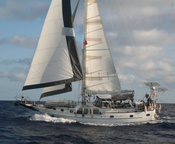Ustupu, San Blas Islands, Panama
Achutupu, San Blas, Panama
Islandia, San Blas Islands, Panama
Aligandi, San Blas Islands, Panama
Snug Harbor, Headed Slowly for Colombia
East Holandes Snorkeling
Chicken Entero
Watermaker Project, Installment #57
Nargana, San Blas, Panama
After picking our friend Jim Yates up at the Mulutupu airstrip at 7:30am, we had a quick breakfast and headed further south.
Our original plan was to go nearly all the way to the Panama/Colombia border the first day, and then dawdle on the way back to fly Jim out of Mulutupu in a week. This is only a total of 60 miles round trip, so entirely doable in a week's 'cruise'. But we heard some other boats talking on the VHF--the first we'd heard in about a week--and decided to stop off and join them at Puerto Escoses.
Puerto Escoses is the site of the Scottish Settlement, originally called New Edinburgh. 5 ships and 2400 people landed to make a settlement in 1698. A year later, one ship with 300 people limped home, the settlement a failure, most of the settlers dead of malnutrition, yellow fever, malaria, and various other tropical diseases. The expedition organizers had sold shares in the 'company' they organized, and a great deal of common and wealthy Scots had invested in the project. Its failure made a
significant dent in Scottish finances for a long time.
Stopping there on this day turned out to be a really good idea. We met up with the other boats, Akka and Raven. Both had recently left Cartagena, headed for the San Blas. Akka had already made friends with "Mr. Green", a Kuna on the small island near the anchorage. Mr. Green is trying to learn English, and seeing their American flag flying, had come by to practice his English (and sell the gringos 'pulpa' (octopus)). Akka asked Mr. Green if he would guide us to the ruins, if we couldn't find
them ourselves.
We first went 'bushwacking' on our own, starting from the beach just in from the anchorage. There was a clear path leading off to where we believed Fort Saint Andrews to have once been. After we wandered around following several paths in the swampy area for an hour or two, finding nothing that looked like remains of civilization, we gave up.
The next day, Mr. Green came by with his buddy in a ulu, and we followed them to the ruins. The first place he took us was where the Scots had cut a canal into the rock, and the remains of the moat around the fort. The canal was impressive, about 10' wide and 25' long, cut into the rock. Since it was done in 1698, it was probably mostly cut by hand. The 'moat' was still discernable in the thick vegetation. But we saw nothing else that looked fort-like.
Next they took us to the spot where the Kit Kap expedition left a concrete marker in the early 1970's. There was some barely discernable writing on the marker that identified it.
Finally, they took us to a site where a Doctor Anderson did some archeological digging. Our guide told us that they found musket balls, cannon balls, small coins, pottery, etc. They said they had dug 3-4 exploratory holes. He only took us to one of the dig sites, as the others were in the muddy area.
At one point when we were walking, he indicated that we were passing the place where the dead were buried. But he didn't stop, and we never saw any physical evidence of it.
I did take my GPS so we could document where the stuff was we found.
Start of canal: 08-50.485N 77-38.251W
End of canal: 08-50.475N 77-38.238W
Small Beach: 08-50.351N 77-38.301W
Monument: 08-50.350N 77-38.357W
Cemetary Area: 08-50.351N 77-38.349W
Excavation: 08-50.408N 77-38.316W
After visiting the canal by dinghy, we dinghied to the 'small beach', left our dinghies there, and then literally bushwhacked to the Monument, thru the Cemetary Area, and to the Excavation. Mr. Green and his buddy both had machetes, and did quite a bit of whacking to make a trail for us. Otherwise we'd have never found it.
Mr. Green also told us that recently the British Ambassador to Panama had visited, and there were discussions about making the site into a park or monument.
Mr. Green's first name is Plaxadis, and he normally lives in the Kuna town of Mulutupu, or on the little island just south of the anchorage in Puerto Escoses. He is the son of a saila (chief) in Mulutupu. He said if anyone else wanted to be guided to the ruins, they should ask for him in Mulutupu or at the island. Apparently he spends 3 weeks on, 3 weeks off, alternating between Mulutupu and farming in Puerto Escoses.
Labels: PanamaCarib
The Blog Template is generated via PsycHo and is Licensed.

